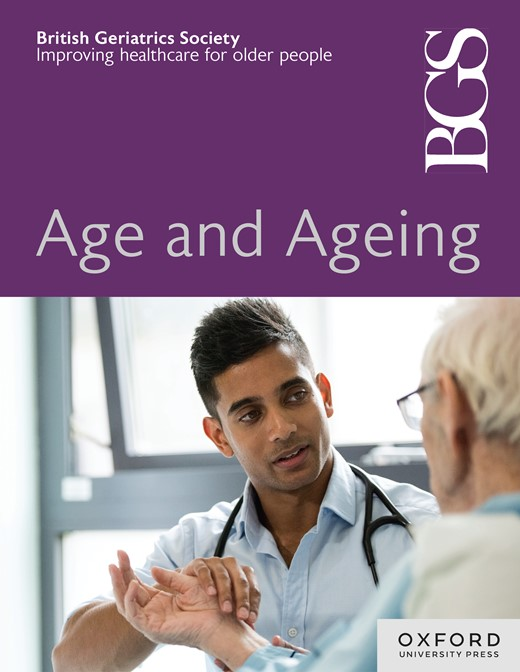3215 Reducing anticholinergic burden (ACB) within the healthcare for older people's (HCOP) wards
IF 6
2区 医学
Q1 GERIATRICS & GERONTOLOGY
引用次数: 0
Abstract
Introduction Medications with anticholinergic properties can have significant adverse effects, particularly in older adults. An Anticholinergic Burden (ACB) score of ≥3 is associated with increased risks of falls, cognitive impairment, and mortality. Additionally, side effects such as urinary retention, visual disturbances, and constipation are frequent contributors to delirium. Aim To assess whether raising awareness of ACB within the Healthcare of Older People (HCOP) department can lead to a reduction in ACB scores. Methods Over four months, a teaching session and a poster was disseminated on ACB. Retrospective data were collected from three separate weeks, one before any intervention, one after the teaching session and one after the poster for patients discharged from the HCOP department. Admission and discharge ACB scores were calculated using the ACB Calculator (www.acbcalc.com). Patients on end-of-life medications were excluded. Results Cycle 1: Of 40 patients, 13 had an ACB score ≥ 3 on discharge. Seven patients retained their admission ACB scores ≥3 at discharge, while eight patients showed a reduction. A lack of awareness of ACB was identified, prompting a teaching session. Cycle 2: Of 33 patients, eight had an ACB score ≥ 3 on discharge, and 11 showed a reduction in scores. A poster campaign was launched across HCOP doctors’ offices. Cycle 3: Among 39 patients, 17 had an ACB score ≥ 3 on discharge. However, this cycle achieved the highest number of score reductions, with 12 patients showing improvement. A side analysis revealed that lansoprazole was the most commonly prescribed medication with anticholinergic properties, affecting 33 patients across the three cycles. Conclusion Raising awareness of ACB scores has successfully reduced ACB scores. Sustained efforts, including regular reminders and medication reviews, are essential to mitigate risks for older patients. Ongoing discussions with the pharmacy team aim to implement an automated ACB score calculation in the online noting system.3215减少老年人保健病房的抗胆碱能负担(ACB)
具有抗胆碱能特性的药物可能有明显的副作用,特别是对老年人。抗胆碱能负荷(ACB)评分≥3与跌倒、认知障碍和死亡风险增加相关。此外,尿潴留、视力障碍和便秘等副作用也是谵妄的常见原因。目的评估提高老年人医疗保健(HCOP)部门对ACB的认识是否会导致ACB评分的降低。方法进行为期4个月的ACB教学,并张贴海报。回顾性数据从三个不同的星期收集,一个是在任何干预之前,一个是在教学课程之后,一个是在HCOP部门出院患者的海报之后。使用ACB计算器(www.acbcalc.com)计算入院和出院ACB评分。接受临终药物治疗的患者被排除在外。第1周期:40例患者中,13例出院时ACB评分≥3分。7例患者出院时ACB评分≥3分,8例患者评分降低。发现了对ACB缺乏认识,促使进行了一次教学。周期2:33例患者中,8例出院时ACB评分≥3分,11例评分降低。一项海报活动在HCOP医生办公室展开。周期3:39例患者中,17例出院时ACB评分≥3。然而,这个周期取得了最多的分数下降,有12名患者表现出改善。一项侧面分析显示,兰索拉唑是最常用的抗胆碱能药物,在三个周期中影响了33名患者。结论提高ACB评分意识,有效降低了ACB评分。持续的努力,包括定期提醒和药物审查,对于减轻老年患者的风险至关重要。正在与药房团队讨论的目标是在在线记录系统中实现自动ACB分数计算。
本文章由计算机程序翻译,如有差异,请以英文原文为准。
求助全文
约1分钟内获得全文
求助全文
来源期刊

Age and ageing
医学-老年医学
CiteScore
9.20
自引率
6.00%
发文量
796
审稿时长
4-8 weeks
期刊介绍:
Age and Ageing is an international journal publishing refereed original articles and commissioned reviews on geriatric medicine and gerontology. Its range includes research on ageing and clinical, epidemiological, and psychological aspects of later life.
 求助内容:
求助内容: 应助结果提醒方式:
应助结果提醒方式:


